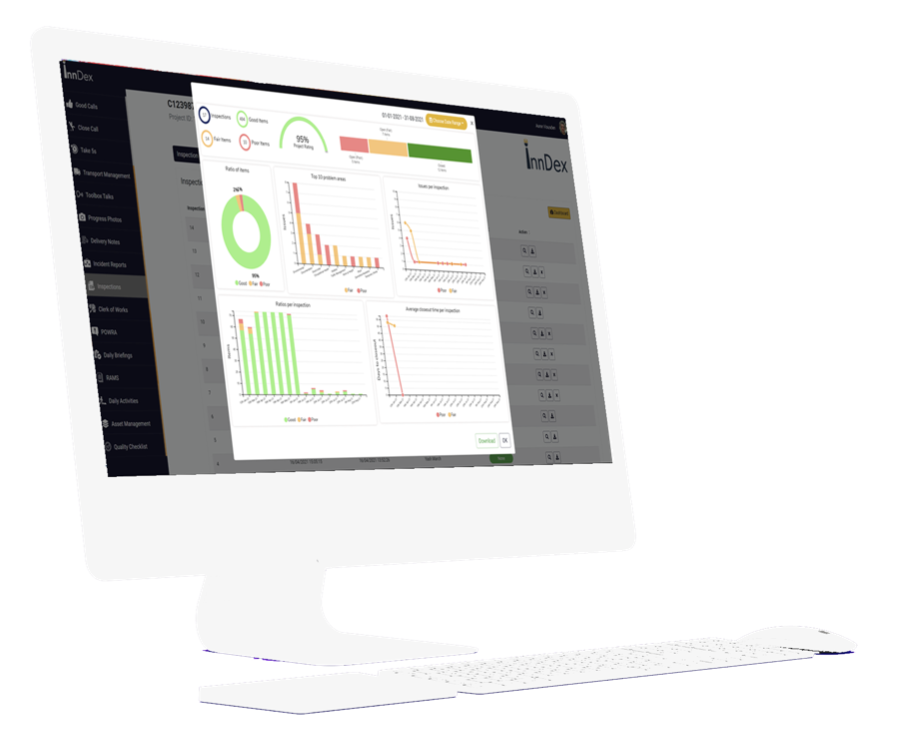Digitisation is real and it’s happening across all industries, and construction is one of them. We’re using more and more digital tools and using platforms and systems to simplify tasks both on site and in the office. We’re using BIM, completing daily reports, and tracking KPIs on our mobile phones. We’re always online and always connected, but why aren’t we building more efficiently and effectively?
Undoubtedly, experience has made our industry’s productivity one of the highest in history, but to this day, productivity levels are at an all time low in construction, a point of shame compared to others. Our intuition can eventually mislead us, and this is where data plays an important part in helping us get back on track.
Luckily (or not), we’re now producing data faster than ever, giving us more information to rely on when it comes to making informed decisions, but just as it’s easy to get lost in data as it is to collect it.
According to a February 2020 report by the Association of General Contractors: “Large infrastructure projects require an average of 130 million emails, 55 million documents, and 12 million workflows. And yet, 13% of construction teams’ working hours are spent looking for this project data. As a result, 96% of the data collected in the construction process goes unused.”
This data could unlock a huge potential to help us increase productivity, safety and save time and money at the same time. Understand what we’re doing wrong, and what we can do to improve processes.
It’s understandable to feel overwhelmed, suspicious and somewhat sceptical towards collecting data, especially in our industry, but how should we overcome this fear?
Analysing data upon project completion drives long-term improvements and we can flatten the learning curve across the whole supply chain. Data tells us a story, gives us direction and proof that we need to change the way we do things.

Ignoring data
=
Huge loss in opportunities now and into the future
The learning curve is still very steep: Kris Lengieza, says that: “as an industry, we have spent the last 5-7 years learning how to collect data, and that only now we’re starting to learn how to use it and to understand its power.”
This means we need to change our approach to how we treat data.
Think of the three Rs, Reduce, Reuse, Recycle: the holy grail of Data Management.
REDUCE
Data silos may seem harmless, but in reality they create barriers to viewing data holistically and hinder the detection of actionable insights, which will harm a business in the long run. Instead we should focus on feeding our valuable information to a single source of truth, to allow transparency across the organisation as well as reducing the burden of multi-platform data entry.
REUSE
Internal data can be reused.
Companies can reuse their data to better understand where any holes in their organisation might be concerning compliance.
Project data can be reviewed upon completion to train the team and drive improvement across the whole supply chain.
RECYCLE
Regulations change more often than we’d like them to and recycling data can be an important component when it comes to ensuring compliance with reporting requirements.
Data recycling can be an incredibly rewarding collaborative effort, and a way to ensure existing data does not go to waste.
Of course, we need to know what data needs to be collected, and why. Even though the points of interest may seem sparse, they all connect after their analysis. Even the simplest things like qualifications, time spent on site, accidents, or even lifestyle can help us get a deeper understanding of an individual’s habits and how they can be improved to maximise a worker’s performance on site.
Why should we care about data?
Because it facilitates decision making.
Everything we do in our daily lives involves decision making, and who wouldn’t want to be able to make better decisions, faster?!
SHARE THIS ARTICLE
RECENT POSTS
-
 Reducing Operational CarbonJune 1, 2021/0 Comments
Reducing Operational CarbonJune 1, 2021/0 Comments -
 Construction Supply Chain DisruptionJune 10, 2020/
Construction Supply Chain DisruptionJune 10, 2020/ -






